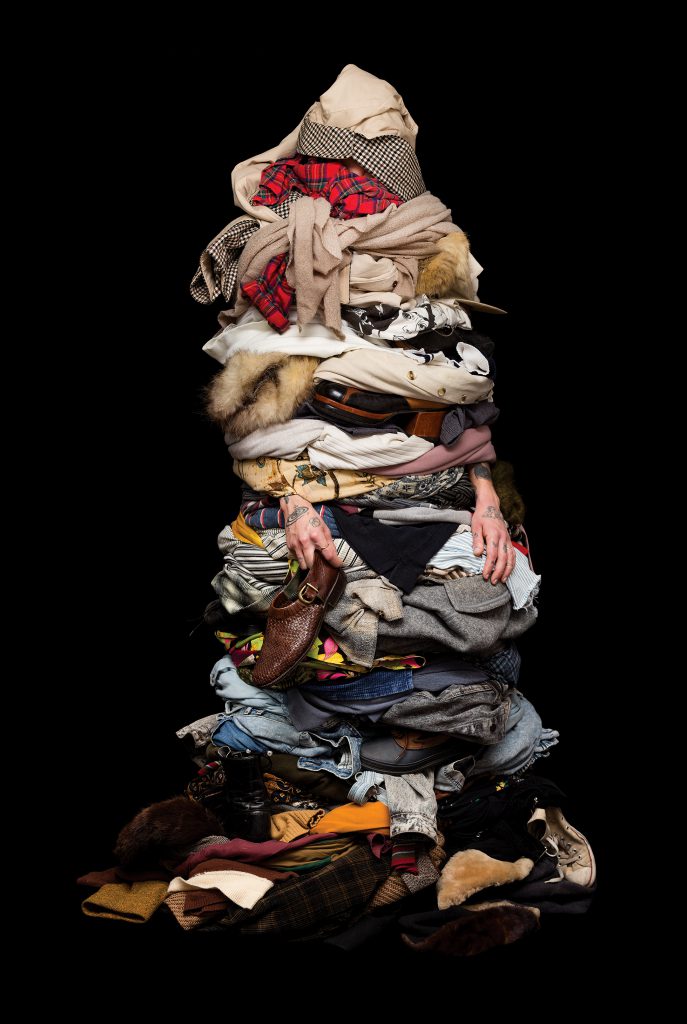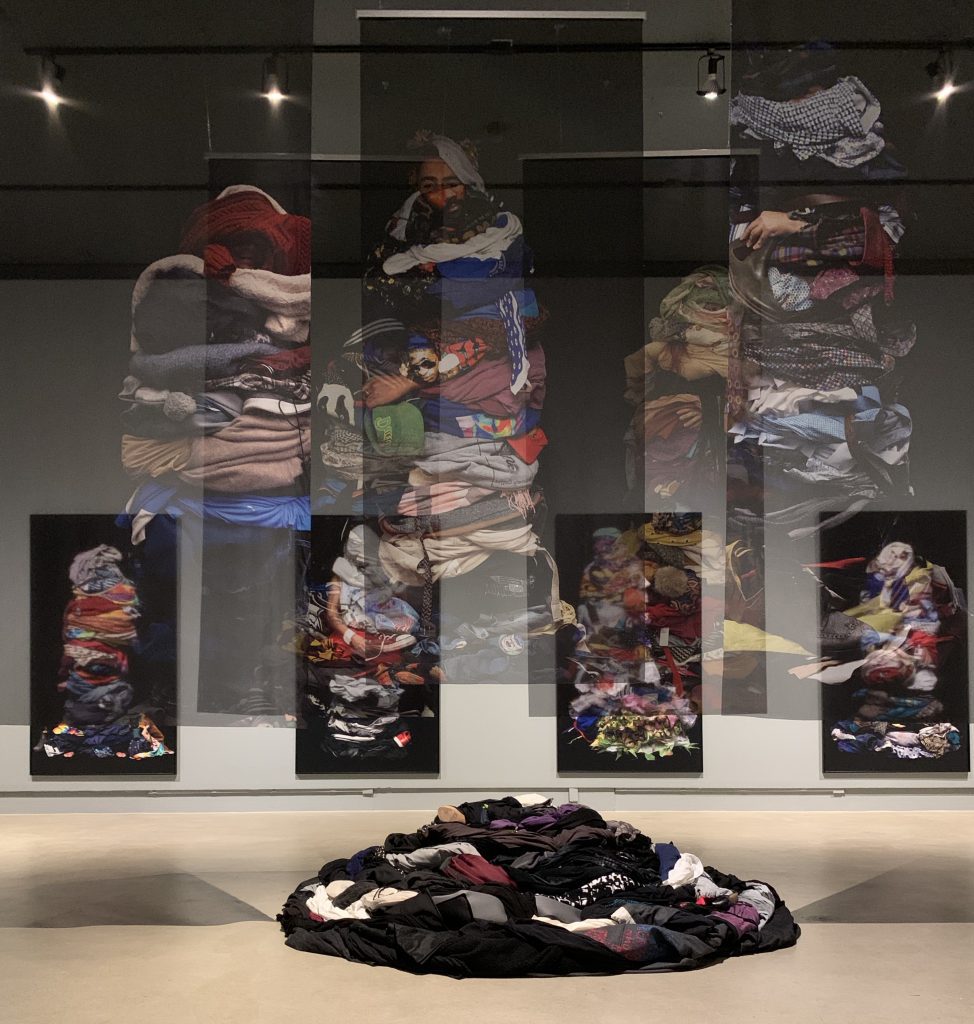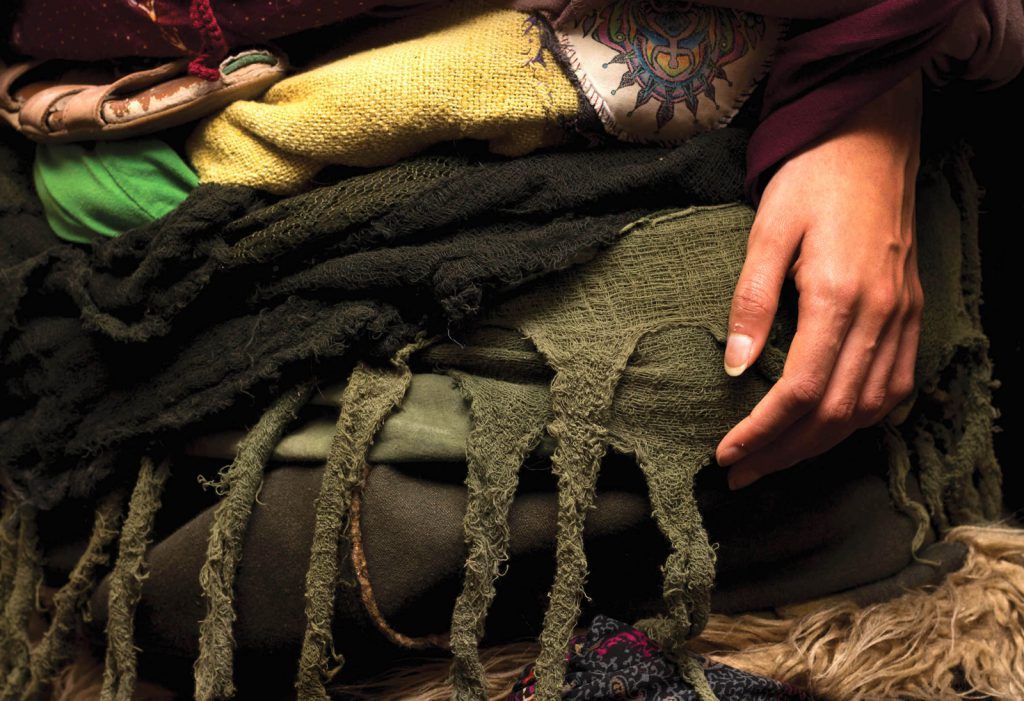A Taxonomy of Strangers: Libby Oliver’s Soft Shells
24 November 2021
By Tyler Muzzin
The photographs in Libby Oliver’s series Soft Shells engender the same paradoxical nature that the title implies: they are portraits that conceal the subject, while revealing more about the subject’s individuality than most portrait photography could ever hope to achieve. Exhibited at Gallery Stratford, on the edge of the Shakespeare Festival grounds and a short walk from one of the most celebrated costume departments in Canadian theatre, it’s only fitting to quote Jaques’ well-worn prologue to Act II of As You Like It as an epigraph:
“All the world’s a stage, / And all the men and women merely players;”
Oliver’s performative methodology is nomadic. For each one-on-one photo session, she enters the subject’s living space with her camera and a portable backdrop. Introductions are made, and for the next fifty minutes, Oliver proceeds to wrap her subject in the entirety of their own wardrobe. The result is a sartorial pillar—a colourful upright cocoon assembled from dozens, maybe hundreds, of personal items: basketball jerseys, jewellery, high heels, dresses, and denim. Within these ephemeral living sculptures, glimpses of the subjects peek through errant folds—a tree tattoo here, a ring-decked knuckle there, a tuft of platinum hair… or is it a wig? The final assemblage is photographed on a backdrop of saturated black. Each image is printed at what appears to be a 1:1 scale (43 in. x 78 in.) and hung just high enough to force the viewer’s neck to crane a little bit, like confronting a quiet, regional saint in the stained-glass alcove of a backroads cathedral.
Oliver describes Soft Shells as a highly relational and collaborative project. Her subjects range in age from 6 days (Ziad, 2017) to 89 years (Florence, 2017), and despite the singularity of each session, Oliver has noticed a trend. The sessions frequently begin with casual conversation, followed by mounting physical discomfort on the part of the model, and sometimes conclude with a sense of panic. This fluctuation of experience becomes tangible to the viewer through the ambiguities of comfort and claustrophobia, protection and vulnerability. Likewise, the soft-shell jacket, a lightly-insulated technical garment, is really only designed to protect those engaged in rigorous outdoor activities like trail running or Nordic skiing; and the soft-shell crab, in an intermediary stage of exoskeletal molting, is selected for harvest only when humans can consume it, shell and all.

The inherent contradiction in all kinds of “soft shells” is also shared, to an extent, by everyday fashion. Likewise, each portrait by Oliver is intricately unique, yet composed of familiar elements, be they brands, trends, or certain ethno-cultural accoutrements. Only a first-name title (i.e. Janine, 2017) tells us all we are to know about the subject of the photo, and viewers are left to form their own judgements based on the assumptions they have carried with them into the gallery. To further complicate the question of individuality, many of the portraits include a wide range of fashion choices, from ball gowns to ball caps, which intimate that constructing a personal wardrobe is a highly fluid and individual process.
In the Stratford iteration of Soft Shells, first exhibited at Québec City’s Musée de la civilisation in 2019, six sheer photo banners drape from the gallery ceiling in an equidistant hexagonal formation. In the centre of the banners, on the floor, is a carefully woven circular mound of clothing belonging to the gallery’s director and curator, Angela Brayham. The translucent banners lack the opulent opacity and clarity of the photographs on the wall, but with the central arrangement of clothes, they encourage a curious sense of performative and material ritual—one that Oliver jokes may be a remnant of her Catholic upbringing. The idea of ritual is significant when considering the quotidian act of getting dressed in the morning. In many ways, it brings to mind a parallel to the perithesis chapters in ancient Greek epics: verbose and highly ornate passages which describe the heroes gearing up for war. The ritual of getting dressed can signify class, employment, climate, gender identity, faith, age—perhaps superficial, but intentional and significant nonetheless. In Canada, the strategy of layering under- and outerwear can be of the utmost importance on days when the meteorological forecast appears to have been drawn from a hat and the temperature fluctuates between single double digits. Moreover, the social response to COVID-19 and the use of face masks—either worn or not worn—adds a new dimension of strategic choice about one’s appearance, and, potentially, the brand of politics one wishes to express publicly.
Encountering the arrangement of the curator’s clothing on the floor, it feels somewhat deflated and powerless as a centrepiece; not like the Shroud of Turin, but more like the Cloak of Obi-Wan Kenobi. I then realize that this reaction is a testament to the enormous presence, if obscured, of the human body in the photographs. Without the presence of the body, the clothes do not undergo the apotheosis that they otherwise would. Instead, they join Liz Magor’s polyurethanes and Michelangelo Pistoletto’s Venus of the Rags (1967) in a long, respectable lineage of conceptual garment sculptures. In our conversation, Oliver mentions Ann Hamilton’s Event of a Thread as an influence. Exhibited at New York’s Park Avenue Armory in 2012, Hamilton’s large-scale installation had viewers riding swings around an enormous central textile piece, while actors read texts and improvised speech through paper-bagged walkie-talkies. This line of influence, addressing ideas of unseen labour and the dissolution of boundaries between artist, actor, participant and spectator, restates Oliver’s intention to make work that is aesthetically pronounced yet deeply collaborative.

Individually, the photographs reveal an adept sense of care and calculation, but the technical achievement of Soft Shells is the consistency Oliver maintains with her systematic approach to seriality—an approach that began in 2017, and has been physically relocated to strangers’ living spaces across much of the country. Rather than setting up, customizing, and refining a single controlled studio space, each in-situ session implies an improvised DIY studio that the viewer never gets to see. As a whole, the series of photographs is as uniform as the zoological taxonomies one would expect to find in a 19th century natural history book. Rather than interpretive illustrations that hold the promise of scientific knowledge, Oliver’s motley collection of strangers exposes nearly everything, but professes nothing.
Jaques’ “All the world’s a stage” monologue is referenced so frequently because of its use as a textbook example of dramatic irony; Jaques himself is a player on the stage of course, and with this declaration he nearly breaks the fourth wall. This meta-theatrical technique is used to voice social and moral statements beyond the drama of the plot, perhaps even to voice the opinions of William Shakespeare, who, like Libby Oliver’s subjects, is only a name tied to various identity clues. The clues in Soft Shells’ portraits connect not only to a person, but to a cultural and geographical timestamp. This is an oversimplification, but you might be able to guess the era I’m thinking of if I were to say Modrobes, bell bottoms, Chip & Pepper, hemp and puka shell jewellery, should these references resonate with you. Perhaps anthropologists of the future will consider Soft Shells an ethnographic resource—however, the accuracy of their deductions will depend on their ability to identify the irony.
Soft Shells by Libby Oliver ran from January 31 – May 1, 2020 at Gallery Stratford in Stratford, ON.
Feature Image: (detail view) Leaf, 2017 by Libby Oliver. Photo courtesy of the artist.



